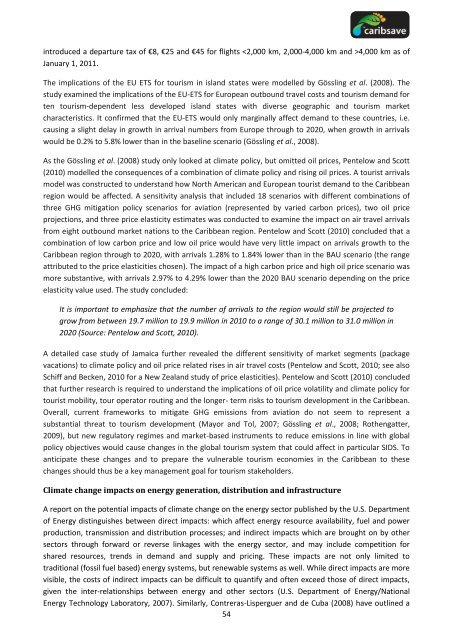You also want an ePaper? Increase the reach of your titles
YUMPU automatically turns print PDFs into web optimized ePapers that Google loves.
introduced a departure tax of €8, €25 <strong>and</strong> €45 for flights 4,000 km as of<br />
January 1, 2011.<br />
The implications of the EU ETS for tourism in isl<strong>and</strong> states were modelled by Gössling et al. (2008). The<br />
study examined the implications of the EU-ETS for European outbound travel costs <strong>and</strong> tourism dem<strong>and</strong> for<br />
ten tourism-dependent less developed isl<strong>and</strong> states with diverse geographic <strong>and</strong> tourism market<br />
characteristics. It confirmed that the EU-ETS would only marginally affect dem<strong>and</strong> to these countries, i.e.<br />
causing a slight delay in growth in arrival numbers from Europe through to 2020, when growth in arrivals<br />
would be 0.2% to 5.8% lower than in the baseline scenario (Gössling et al., 2008).<br />
As the Gössling et al. (2008) study only looked at climate policy, but omitted oil prices, Pentelow <strong>and</strong> Scott<br />
(2010) modelled the consequences of a combination of climate policy <strong>and</strong> rising oil prices. A tourist arrivals<br />
model was constructed to underst<strong>and</strong> how North American <strong>and</strong> European tourist dem<strong>and</strong> to the Caribbean<br />
region would be affected. A sensitivity analysis that included 18 scenarios with different combinations of<br />
three GHG mitigation policy scenarios for aviation (represented by varied carbon prices), two oil price<br />
projections, <strong>and</strong> three price elasticity estimates was conducted to examine the impact on air travel arrivals<br />
from eight outbound market nations to the Caribbean region. Pentelow <strong>and</strong> Scott (2010) concluded that a<br />
combination of low carbon price <strong>and</strong> low oil price would have very little impact on arrivals growth to the<br />
Caribbean region through to 2020, with arrivals 1.28% to 1.84% lower than in the BAU scenario (the range<br />
attributed to the price elasticities chosen). The impact of a high carbon price <strong>and</strong> high oil price scenario was<br />
more substantive, with arrivals 2.97% to 4.29% lower than the 2020 BAU scenario depending on the price<br />
elasticity value used. The study concluded:<br />
It is important to emphasize that the number of arrivals to the region would still be projected to<br />
grow from between 19.7 million to 19.9 million in 2010 to a range of 30.1 million to 31.0 million in<br />
2020 (Source: Pentelow <strong>and</strong> Scott, 2010).<br />
A detailed case study of Jamaica further revealed the different sensitivity of market segments (package<br />
vacations) to climate policy <strong>and</strong> oil price related rises in air travel costs (Pentelow <strong>and</strong> Scott, 2010; see also<br />
Schiff <strong>and</strong> Becken, 2010 for a New Zeal<strong>and</strong> study of price elasticities). Pentelow <strong>and</strong> Scott (2010) concluded<br />
that further research is required to underst<strong>and</strong> the implications of oil price volatility <strong>and</strong> climate policy for<br />
tourist mobility, tour operator routing <strong>and</strong> the longer- term risks to tourism development in the Caribbean.<br />
Overall, current frameworks to mitigate GHG emissions from aviation do not seem to represent a<br />
substantial threat to tourism development (Mayor <strong>and</strong> Tol, 2007; Gössling et al., 2008; Rothengatter,<br />
2009), but new regulatory regimes <strong>and</strong> market-based instruments to reduce emissions in line with global<br />
policy objectives would cause changes in the global tourism system that could affect in particular SIDS. To<br />
anticipate these changes <strong>and</strong> to prepare the vulnerable tourism economies in the Caribbean to these<br />
changes should thus be a key management goal for tourism stakeholders.<br />
Climate change impacts on energy generation, distribution <strong>and</strong> infrastructure<br />
A report on the potential impacts of climate change on the energy sector published by the U.S. Department<br />
of Energy distinguishes between direct impacts: which affect energy resource availability, fuel <strong>and</strong> power<br />
production, transmission <strong>and</strong> distribution processes; <strong>and</strong> indirect impacts which are brought on by other<br />
sectors through forward or reverse linkages with the energy sector, <strong>and</strong> may include competition for<br />
shared resources, trends in dem<strong>and</strong> <strong>and</strong> supply <strong>and</strong> pricing. These impacts are not only limited to<br />
traditional (fossil fuel based) energy systems, but renewable systems as well. While direct impacts are more<br />
visible, the costs of indirect impacts can be difficult to quantify <strong>and</strong> often exceed those of direct impacts,<br />
given the inter-relationships between energy <strong>and</strong> other sectors (U.S. Department of Energy/National<br />
Energy Technology Laboratory, 2007). Similarly, Contreras-Lisperguer <strong>and</strong> de Cuba (2008) have outlined a<br />
54





